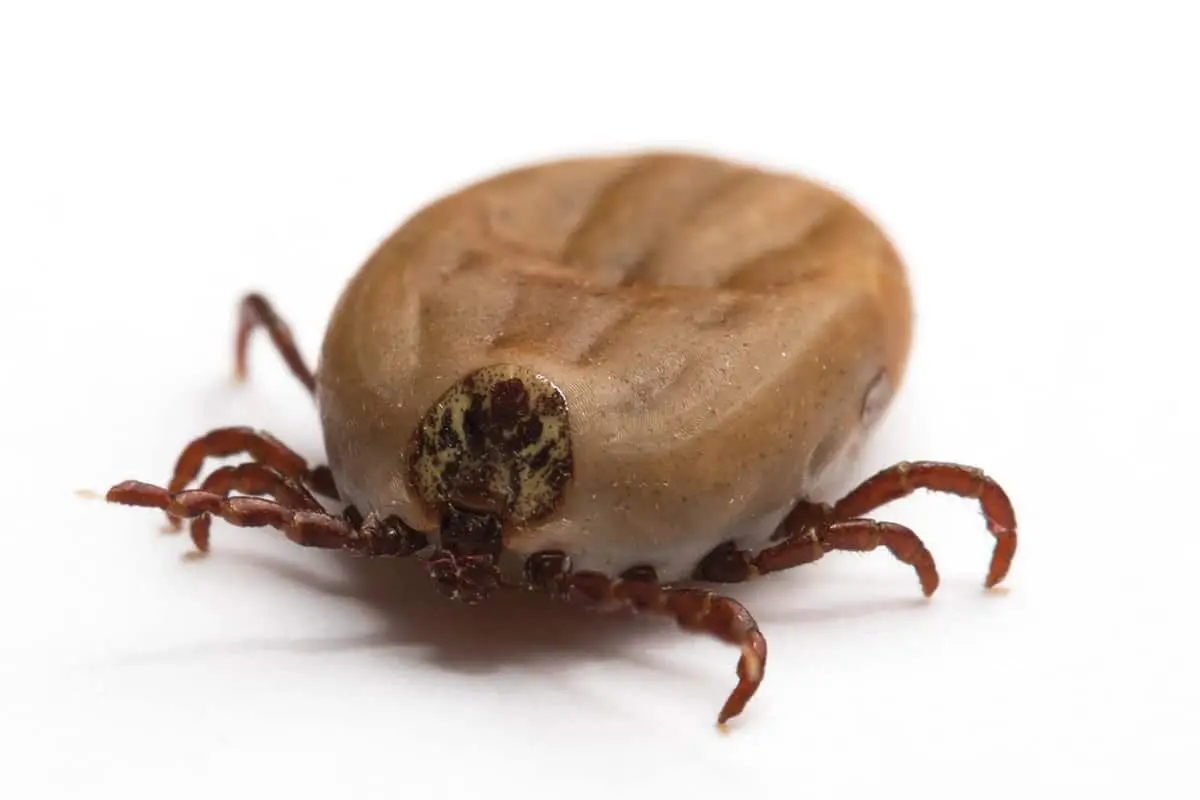By Kate Hull Heidenreich // Illustrations by Stacey Walker Oldham
—
For such tiny creatures, ticks bring a mammoth-size list of concerns. If you’ve ever stuffed your kiddo’s pants into their socks before cruising the woods, or performed a post-hike head-to-toe tick check, you’re likely aware of the anxiety these eight-legged nuisances can cause. But beyond their potentially disease-spreading bites, the critters are also the source of a laundry list of hot-button issues.
Why the fuss over these micro-menaces? Ticks are known to carry disease caused from ingesting the blood of disease-carrying birds, rodents, and other animals. The disease is then passed onto humans and dogs from the ticks’ biting and burrowing into the skin. In fact, ticks are responsible for transmitting more diseases to humans than any other bug. The most commonly known ailments spread are tularemia, Rocky Mountain spotted fever, Colorado tick fever, and Babesiosis. But arguably, the most well known of all is Lyme disease.
Ticks in Wyoming and the Intermountain West apparently don’t carry Lyme disease, as they do in the Midwest and eastern states (more on this later). But the western species’ bite still packs a potential punch, bringing on some of the not-so-welcomed aforementioned diseases. Come early May through July, tick season is in full force out West. And although relatively rare—each year, just over 100 cases of tularemia and around 500 of Rocky Mountain spotted fever are reported—these illnesses can be severe if not treated.
Ticks: No, they are not insects.
These creepy-crawlies are, in fact, not insects. They are a part of the spider family, arachnids, with hundreds of varieties throughout the world. The most common types are the American dog tick and the blacklegged tick (or deer tick), found in the Midwest and eastern United States, and the brown dog tick, found nationwide. The Rocky Mountain wood tick is common mostly in the Intermountain West. And the blacklegged tick is the best known for spreading Lyme and other disease in the northeastern, Mid-Atlantic, and north-central parts of the country.
Ticks have a complex life cycle of four stages: egg, six-legged larva, eight-legged nymph, and adult. Once hatched, these tiny arachnids are on the hunt for blood to sustain themselves—so the search for a host begins. Although some species of ticks prefer to latch onto one host for the entirety of its life (which can last up to three years), many go from mammal to mammal and spread disease, according to the Center for Disease Control.
These tiny bloodthirsty critters hook onto a blade of grass or a leaf with only a few of their legs firmly attached, while the other appendages calmly wait for a warm body to pass by. This patient waiting game is called questing. When the moment arises, they climb onto their host. And then there’s more … Ticks latch on, cut into the skin, and begin feeding for anywhere from minutes to hours. (The CDC reports a tick needs to be attached for more than 36 hours to spread Lyme.) The search for a host sounds like a plot from a bad horror movie, but that’s how it works.
Ticks are so tough to remove because of a superglue-like substance they excrete and barbs that make it easy for them to attach to one place. And then they bite—which often initiates the spread of disease. If the mammal has a blood-borne infection, the pathogens are ingested by the tick. If the tick is already carrying a pathogen, its saliva enters the skin and can transmit the pathogen to the host.
Okay. So this part is over. I promise. But the fear of tick-borne illness is real, making the post-outdoor-excursion-tick-search a norm in many parts of the country. And there is a host (no pun intended) of songs to go with it, about the romance of checking your partner for ticks.
The Lyme Lowdown
Lyme disease is caused by the spiral-shaped bacteria Borrelia burgdorferi. The symptoms of Lyme run the gamut of medical issues, from flu-like symptoms and fatigue, to headaches, stiff neck, swollen lymph nodes, and joint paint.
“Lyme is a bacteria,” says Dr. Jason West, DC, NMD, FIAMA, DBDCN, of the West Clinic in Pocatello. The clinic is a nationally recognized alternative medical provider led by this fourth-generation healer. “And we are beginning to understand more and more about the bacteria’s phases and patterns.”
One of the most common symptoms is the bull’s eye rash that sometimes appears after one contracts the bacteria. For many diagnosed with Lyme, the rash is a clear indicator. Once the rash appears and is identified, a regimen of antibiotics is typically prescribed to keep symptoms at bay. But the bacteria can remain inactive in a person’s system long after antibiotic treatment, and can lead to problems later on, a condition known as chronic Lyme disease.
The water gets muddied on diagnosis, however, when there is no rash. Patients might not even find a tick, leaving the onslaught of symptoms a guessing game for both patient and medical professional.
But Are WE Safe?
The CDC reports that up to 30 percent of deer ticks carry the bacteria associated with Lyme, which makes the need to protect oneself vital. The East, Midwest, and Mid-Atlantic states are known to have large populations of Lyme-carrying ticks. But no scientifically backed data shows that the species of ticks native to the western United States carry Lyme disease.
“Spring and summer months are typically the peak months for Wyoming’s tick populations,” says Dr. Alexia Harrist, the state epidemiologist and public health sciences section chief for the Wyoming Department of Health. “We often get questions about … tick-related illnesses, such as Lyme disease or Powassan disease. And while those illnesses can be a concern if you travel out of state, they are not known to be spread in Wyoming.”
According to the CDC, the brown dog tick and the Rocky Mountain wood tick both inhabit the Intermountain West, but have not been found to be carriers of Lyme. This is based on knowledge of the climates where certain species can survive. Lyme-carrying deer ticks thrive in high-humidity areas during the summer months. Ticks living in our high, dry climate have not been shown to carry Lyme. A 2015 study by the CDC found that 95 percent of confirmed Lyme disease cases were reported from fourteen states, predominately in the Northeast and the Midwest.
(Okay, I know this information is incredibly weighty and I’m sure it has raised some hairs on a few readers’ backs. I also realize that endless personal anecdotes, dozens of differing opinions, and a multitude of studies exist on this subject. But honestly, to fully tackle ticks and Lyme disease would take a tome. So, here’s the counter in brief …)
The Gap States: Living with Lyme Disease
There is currently quite a bit of conjecture regarding Lyme: How far ticks travel, the effects of climate change on tick migration, and how bacteria are spread. While these questions still go largely unanswered, the certainty is that there are people struggling with Lyme in each and every state.
Angela Daenzer lives in Columbia Falls, Montana, and has suffered from Lyme for almost seven years, but was misdiagnosed for over three. “I was bitten by a tick while working as a federal wildlife biologist in Montana, but was told by doctors it was not possible to contract Lyme in Montana,” she recalls. Doctors explained to Daenzer that the disease might have been dormant after having been contracted by another tick in a different region. But Daenzer recalls only the one tick bite in Montana.
Montana is known as a “Lyme disease gap state,” Daenzer says, or a geographic area where Lyme is not thought to occur. “Lyme is easy to contract, hard to diagnose, hard to treat, and is very often accompanied by additional hard-to-detect tick-borne infections that can further complicate treatment,” she explains.
The CDC’s Lyme disease map shows only where Lyme is diagnosed, not where it is contracted.
“If you live in a non-endemic state, you may have a lower chance of contracting Lyme, but your odds of a timely diagnosis can be slim to none in areas where Lyme-infected ticks are not being actively looked for,” Daenzer says.
Unsure of how to navigate dealing with the disease in this region, she started the Northern Rockies Lyme Disease Coalition, an active yet informal support group created to help connect Lyme sufferers in the Intermountain West with resources and support. “[People who come to us with Lyme] tend to live in areas where information is missing,” Daenzer says. “Many of these areas also lack adequate resources for detection and treatment.” The American Lyme Disease Foundation and the Global Lyme Alliance are headquartered in Connecticut, a hub for Lyme research, outreach, and patient care—and nowhere near Montana, Idaho, or Wyoming. (In fact, the disease is named for where it was first diagnosed, Old Lyme, Connecticut.)
“Like many patients I’ve talked to in Montana, Wyoming, Alberta, and similar regions, I had to travel out of state for diagnosis and care,” Daenzer says.
The Quest For Care
In eastern Idaho, the West Clinic works to close the “gap.” They offer the full spectrum of care, from Western practices to alternative medicine, and integrated options like biomechanical therapy, energy medicine, and natural medicine. Patients travel from across the country seeking Dr. West’s expertise in Lyme disease.
“Lately, I have seen more awareness for Lyme and chronic disease, but I don’t think there is more disease, just more people being properly diagnosed,” he says. “For years, a patient might have been told they have fibromyalgia or chronic fatigue [syndrome]—all these varying diagnoses. In the medical world, it’s too often ‘you name it, blame it, and contain it.’”
At the West Clinic, each patient is treated as an individual who needs a customized treatment plan—a belief that is at the foundation of this long-standing medical facility. Dr. West’s mission is to help solve chronic illnesses, which cause an estimated 70 percent of patient deaths in the United States. “These diseases eat up upwards of 70 percent of our health care resources and are all based on lifestyle choices,” he says.
West’s passion for alleviating chronic illnesses stems from his treatment of Lyme disease, which is how he became renowned in his field. To him, if you are healthy and your immune system is balanced, your body will be able to successfully fight off infection. “For the sake of example, I will say this:
When you deviate from your perceived view of God’s law, religion calls that a sin. So, a deviation from physical law is a symptom. If you fix the deviation, you get rid of the symptom.”
But a symptom, he says, is good.
“A symptom tells you something is wrong. Your body doesn’t hide it.”
To treat Lyme disease using Western medicine, a doctor might prescribe a two-week dosage of antibiotics to fight the infection. The issue here, West explains, is that your body might not be balanced enough to keep the infection away. “I don’t believe someone can completely get rid of Lyme disease, but I do believe you can take someone and make him or her completely normal, without symptoms,” he says.
West works with a patient to manage stress, follow healthy eating habits, drink adequate quantities of water, balance hormones, and find the right vitamin regimen. For Dr. West, it’s all about empowering patients to take ownership of their treatment. “The Latin root for doctor is doceri, which means teacher,” he explains. “I’m supposed to help you learn what your body needs, whether that’s to fight Lyme or any other chronic disease.”
For West and Daenzer, an important component of the Lyme discussion is education. Currently, Yale epidemiology researchers home in on the link between climate change and the increase in viable habitats for ticks. (Oops, I’m raising eyebrows again.) As long as the Teton area keeps its arid, cool summers and low humidity, Lyme-carrying ticks should stay at bay. But no matter your location—whether you’re trekking through the Tetons or exploring beaches back East—experts agree, no tick is a good tick.
Tick Check Tip Sheet
1. Tuck your pants into your socks along trails and in tick-infested locations such as shrublands, lightly wooded areas, and open grasslands. This will minimize the access point to your skin.
2. Carry tweezers in your pack to easily remove ticks on both yourself and your pets.
3. Wear light-colored clothing so you can easily spot the dark bugs.
4. Do a mid- and post-hike tick check on you, your kids, and your pets.
5. Ticks love moist areas, like leaf piles and shady shrubs. Pay special attention to your kids after they’ve had a fun romp in such areas.
6. Typical bug spray with DEET is no match for ticks. You can skip the DEET and opt for insecticide-treated clothing (Eek!) or natural essential oil repellents, like rose geranium or lemon eucalyptus.





